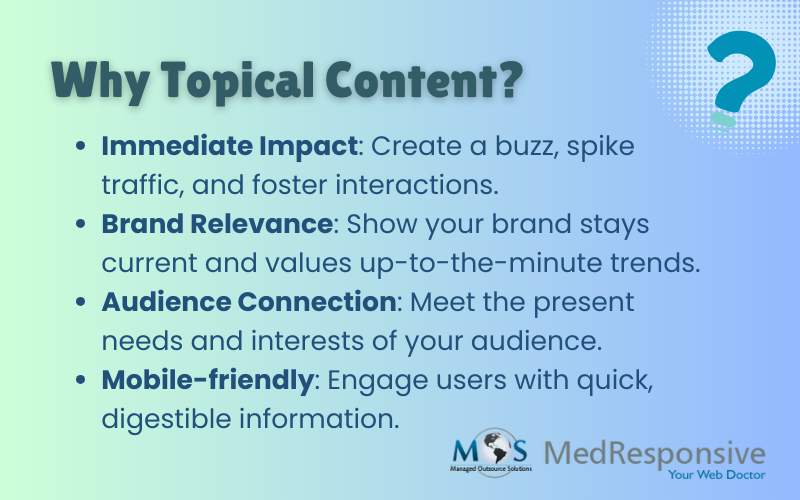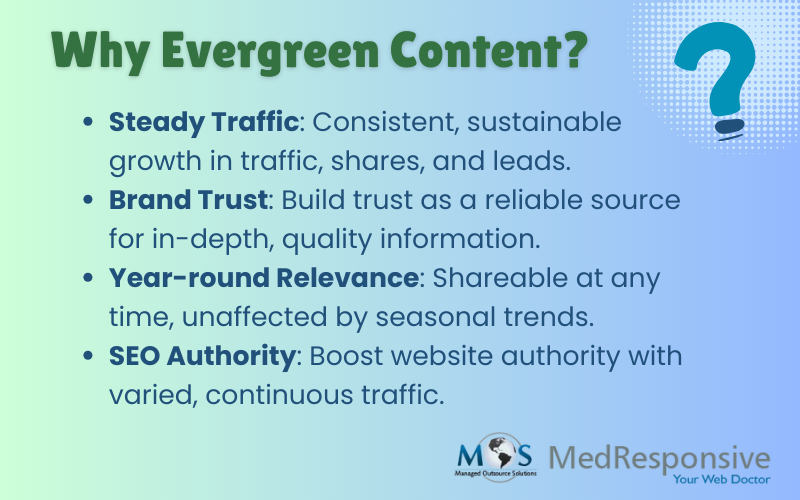When it comes to content creation, the two primary types that always often lead the conversation are: topical and evergreen content.
Google processes over 16.4 billion searches everyday, as marketers are often left with making one of the hardest decisions regarding their content marketing strategy. With so many eyes online looking for answers, your job is to be the answer they find. Both have unique advantages and serve different purposes, making them indispensable aspects of marketing.
So, how do you know what kind of content will catch their eye? Should I focus on trending content or content that builds reputation organically?
Without any further ado, let us address any content marketer’s classic dilemma: topical vs evergreen content. This guide will explore how to effectively use them depending on your goals, audience and how your brand can show up in the search engine results pages (SERPs) with a balanced content marketing strategy.
What is Topical Content?
Topical content refers to the latest/updated topics, viz, current affairs, trends which are now viral with proactive engagement across the internet landscape. It’s the type of content that captures the audience’s immediate interest due to its relevance to current happenings. However, like any social media trend, it may fade fast.
Common Topical Content Examples:
- A blog post about Google’s latest Pixel phone release
- Coverage of the 2022 Soccer World Cup in Qatar
- An article on the newest AI tool everyone’s talking about
- “SpaceX’s extraterrestrial expeditions for 2025”
Keep in mind that topical content is time-sensitive—often seasonal or event-driven, which means it is meant to ride the wave of what’s popular right now and might fade after a certain period of time.
Pros and Cons of Topical Content
| Pros | Cons |
|---|---|
| Instant dose of traffic surge | Short lifespan (today’s trending story is tomorrow’s forgotten one) |
| Best suited for brand launch and social shares | Requires quick turnaround and constant updates |
| Keeps your site fresh and relevant | Chances of losing SEO value over time |
| Helps position you as a thought leader in your niche |
What is Evergreen Content?
Evergreen content, on the other hand, is more like that wise friend that delivers consistent traffic and long-term content SEO benefits, whose advice never goes out of style. Evergreen blog content, for instance, is relevant, valuable and timeless, even long after it’s published—sometimes for years.
Common Evergreen Content Examples:
- “How to Use Data and Research to Enhance Your Content Writing“
- “Key Considerations While Outsourcing SEO“
- “5 Proven Ways to Improve Your Organic Click-through Rates“
- “What Is the Difference between Earned Media and Paid Media?“
This content isn’t tied to viral trends or news cycles — it provides answers to questions that people are always asking.
Pros and Cons of Evergreen Content for SEO
| Pros | Cons | Long-lasting SEO benefits | Takes time to build traffic and reputation |
|---|---|
| Regular traffic over time | Might not drive as many instant shares |
| Less frequent updates required | Can feel “boring” and redundant, if not done right |
| Strong potential for backlinks |
Topical or Evergreen? When to Use Each Type of Content
Topical content should be your go-to strategy when:
- You want to boost traffic quickly,
- Your brand is covering events, product launches, or industry news,
- You want to join trending conversations on social media,
- You’re vying for seasonal campaigns (Black Friday, Christmas, etc.)
Consider this strategy as a way to stay in the loop and prove your brand knows what’s going on.
Pro tip:
In order to know what’s going around, use Google Trends, X (Twitter), and Reddit to spot what’s hot and build timely content around it.
Evergreen content works best when you are looking to:
- Establish authority in your field,
- Rank consistently in search results over time,
- Provide valuable, foundational content for your audience,
- Support lead generation and long-term marketing funnels.
When it comes to educational resources, FAQs, how-tos, or product guides, evergreen is the way to go.
Pro tip:
Evergreen content can always be updated to stay fresh—think of it as a plant, not a statue.
Which Strategy to Focus On for Best Results
Both. However, the ratio depends on your goals.
- Goal: Brand Awareness & Instant Buzz
It is best to lean more into topical content. Make sure to post timely blogs, social posts, or video reactions that will get people talking.
- Goal: Long-Term Growth and Lead Generation
Invest your time and resources in evergreen content. Build an archive of resources, guides and articles that will bring organic traffic for months (or years).
A healthy content strategy blends both types to balance short-term wins with long-term gains.
How to Balance Evergreen and Topical Content
OK. You’ve decided to have the best of both worlds by opting for a mix of topical and evergreen content marketing strategy. Here is how you could achieve that:
- Build “Evergreen” Foundations
It is important to start off with strong evergreen pieces: guides, FAQs, listicles, tutorials. These actually form the backbone of your content strategy.
- Align Topical Content on Top
Utilize savvy topical blogs or videos to add that “spice”—talk about current events, tech trends, or respond to breaking news that aligns with your niche.
- Update Evergreen Content Regularly
Evergreen doesn’t mean “never touch it again.” Ensure regular updates in the form of stats, examples, or references at least twice a year to keep it relevant.
- Repurpose Topical Into Evergreen
If a trending post did really well, consider reworking it into an evergreen piece. For example, a blog written in 2022 about “The Future of AI in 2024” can become “AI Trends to Watch in the Next 5 Years.”
- Use Topic Clusters
Group related content, both evergreen and topical around central themes. It helps with SEO and keeps readers on your site longer.
The Impact of Topical and Evergreen Content on SEO
Remember, Google doesn’t just want any content; it wants the right content at the right time.
- Topical content signals freshness and staying relevant with present trends.
- Evergreen content builds authority and depth, while gaining steady traffic.
- A balanced strategy improves crawlability, engagement, and rankings.
If you want to own your niche online, you just can’t afford to rely on just one type of content. A smart SEO strategy plays both the short and long game.
MedResponsive: Your Go-To Partner for Content Strategy Success
With the pros and cons, do’s and don’ts well laid out, it’s time to set a plan for the future. However, juggling trending topics, content calendars, SEO updates, and performance tracking isn’t exactly a cakewalk. And, that’s where we come in.
We don’t just write content—we craft tailored strategies that blend evergreen strength with topical buzz. Whether you’re in healthcare, legal, tech, or eCommerce, we know how to get your brand found, clicked, and remembered.
Final Thoughts
Summarizing, topical and evergreen content aren’t rivals but teammates. While one grabs attention, the other helps build authority. And when used together, they can supercharge your SEO and create a content ecosystem that works round-the-clock for your brand.
So, whether you’re looking to surf the next trending wave or plant your brand’s roots firmly into the ground, your content strategy should never be one-dimensional. It is important to mix it up, monitor performance, and adjust as needed. And, if you ever feel stuck, you know who to call!






